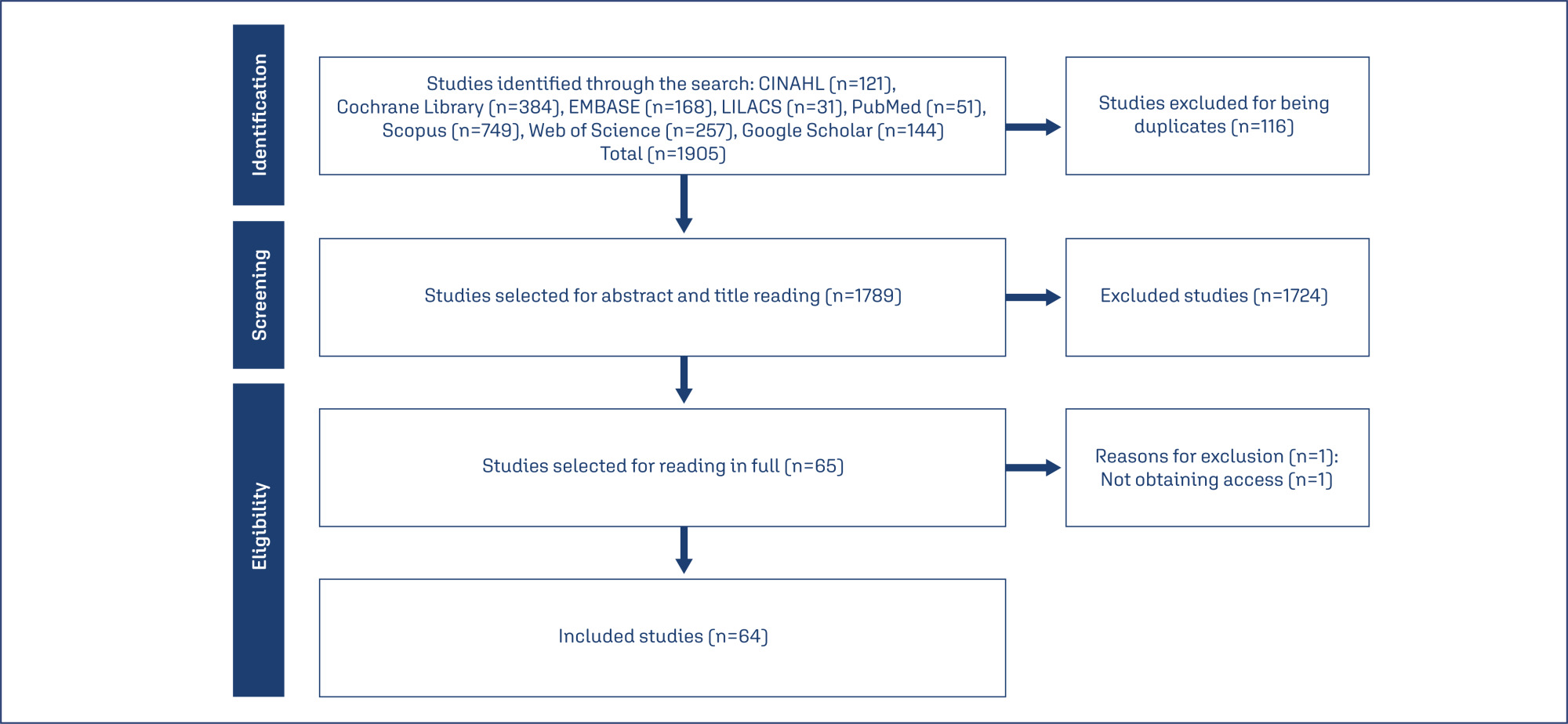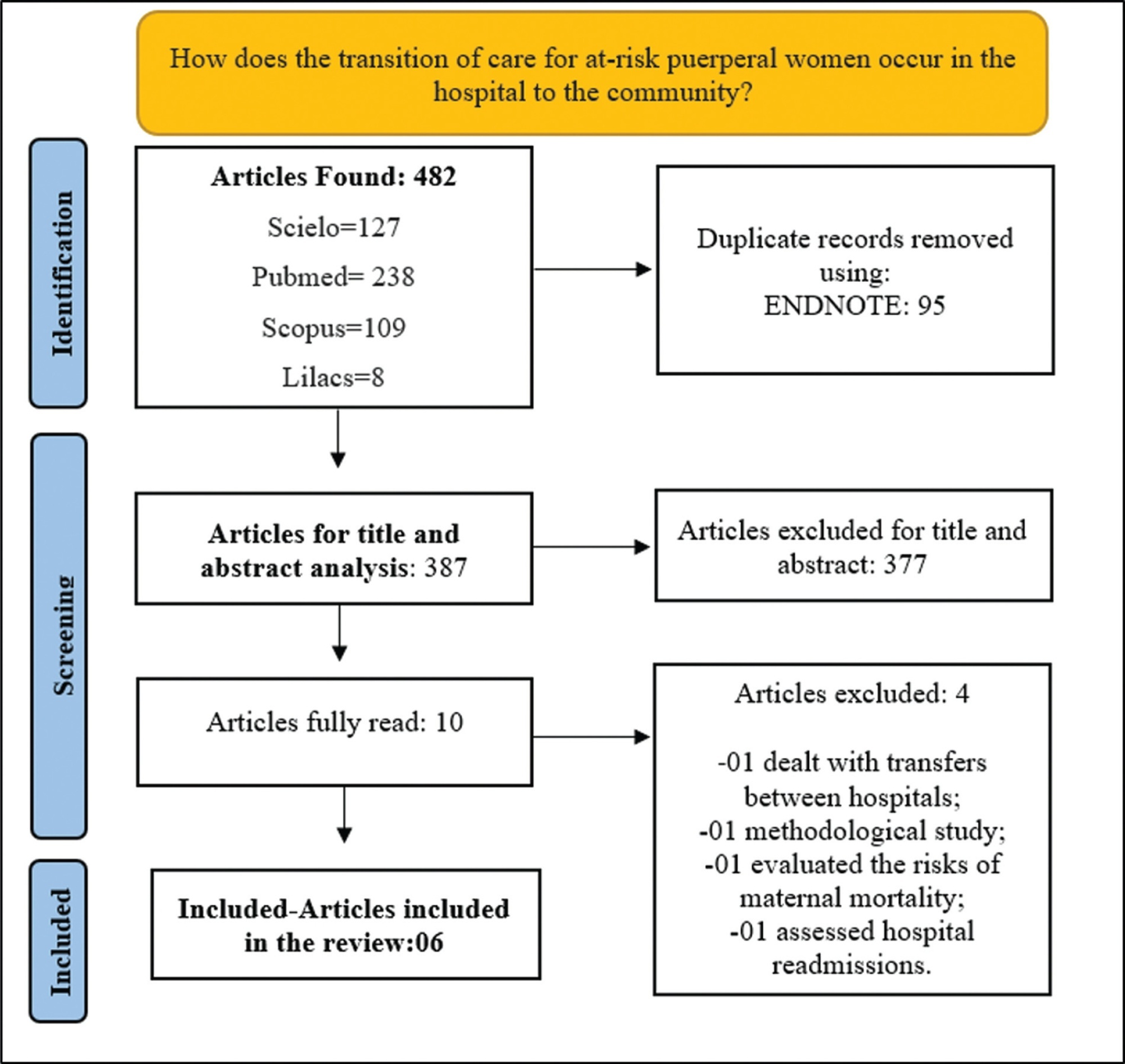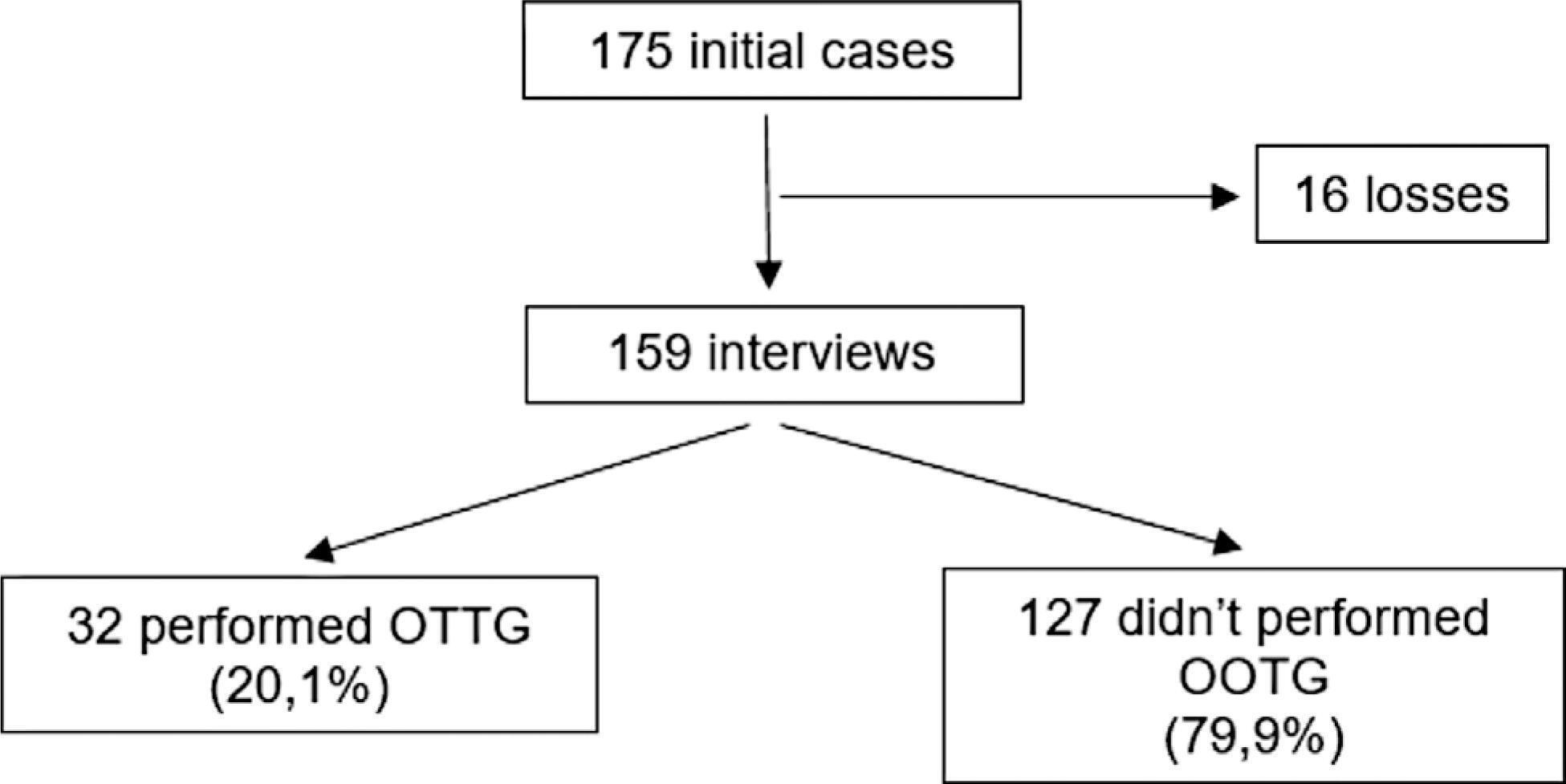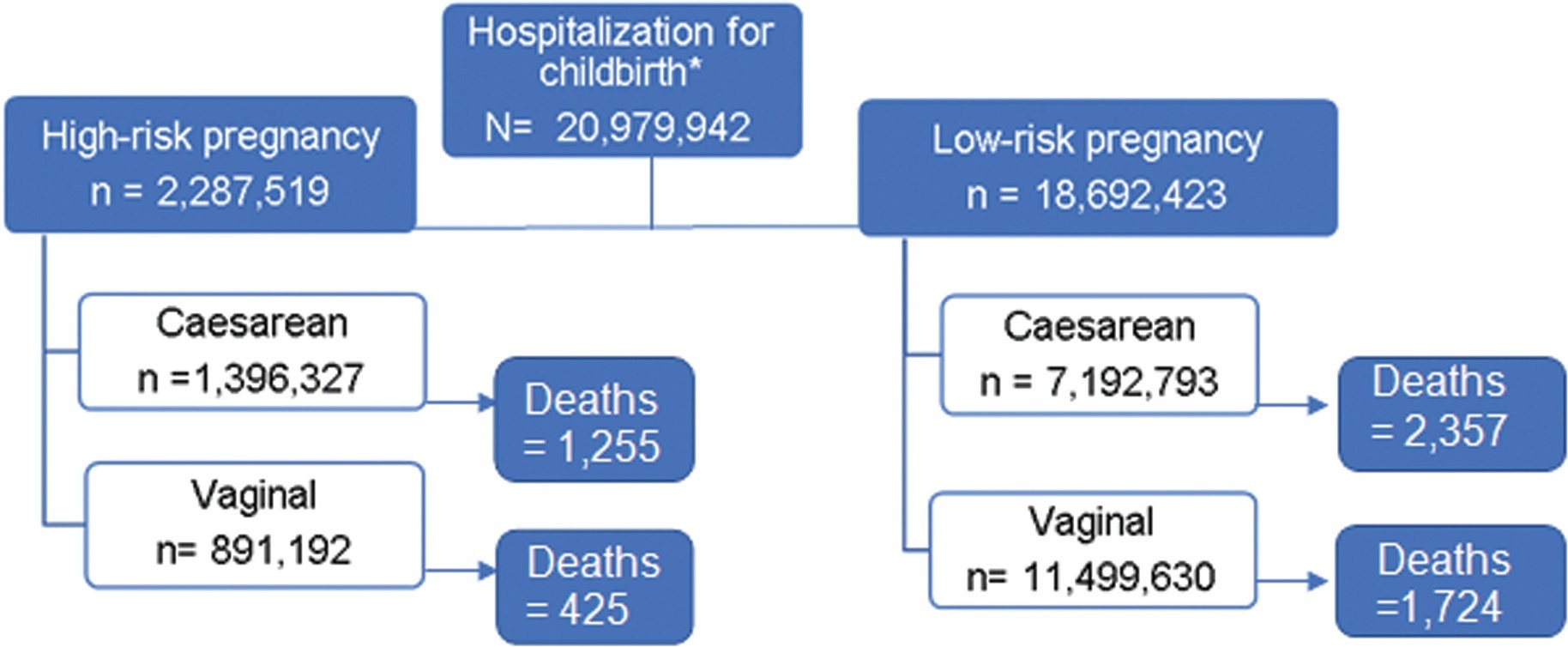Summary
Rev Bras Ginecol Obstet. 2024;46:e-rbgo23
To assess the rate of missed postpartum appointments at a referral center for high-risk pregnancy and compare puerperal women who did and did not attend these appointments to identify related factors.
This was a retrospective cross-sectional study with all women scheduled for postpartum consultations at a high-risk obstetrics service in 2018. The variables selected to compare women were personal, obstetric, and perinatal. The variables of interest were obtained from the hospital's electronic medical records. Statistical analyses were performed using the Chi-square, Fisher's exact, or Mann–Whitney tests. For the variable of the interbirth interval, a receiver operating characteristic curve (ROC) was used to best discriminate whether or not patients attended the postpartum consultation. The significance level for the statistical tests was 5%.
A total of 1,629 women scheduled for postpartum consultations in 2018 were included. The rate of missing the postpartum consultation was 34.8%. A shorter interbirth interval (p = 0.039), previous use of psychoactive substances (p = 0.027), current or former smoking (p = 0.003), and multiparity (p < 0.001) were associated with non-attendance.
This study showed a high rate of postpartum appointment non-attendance. This is particularly relevant because it was demonstrated in a high-risk obstetric service linked to clinical severity or social vulnerability cases. This highlights the need for new approaches to puerperal women before hospital discharge and new tools to increase adherence to postpartum consultations, especially for multiparous women.
Summary
Rev Bras Ginecol Obstet. 2024;46:e-rbgo4
To classify the bibliometric indicators of online scientific research on placentophagy.
A bibliometric study was conducted to quantify the scientific production of authors and institutions with the aim of highlighting the growth and impact of these publications nationally and internationally. The Bradford Law, network maps, and textual statistics were used, with searches conducted in libraries and databases in October 2021.
The sample consisted of 64 articles, whose primary authors were associated with 49 institutions, and mostly with degrees in anthropology. The United States of America was the country that published the most papers on the theme, and most studies were reviews with individual production. Through the term analysis, it was found that the predominant themes regarding placentophagy were the following: Alternative therapy for women's health, methodologies used for research in this area, period of placenta ingestion (postpartum period), and its benefits.
The bibliometric indicators found are essential for the development of future research.

Summary
Rev Bras Ginecol Obstet. 2023;45(9):524-534
To assess the knowledge, attitude, and practice of Brazilian physicians about immediate postpartum and postabortion intrauterine device insertion.
Cross-sectional online survey involving physicians on duty in public Brazilian hospitals. Participants answered an anonymous questionnaire with close-ended questions to assess their knowledge, attitude, and experience on the immediate postpartum and postabortion insertion of copper intrauterine devices.
One hundred twenty-seven physicians working in 23 hospitals in the 5 geographic regions of Brazil completed the questionnaire. Most were female (68.5%) and worked in teaching hospitals (95.3%). The mean (standard deviation) knowledge score (0–10 scale) was 5.3 (1.3); only 27.6% of the participants had overall scores ≥7.0. Most physicians (73.2%) would insert a postpartum intrauterine device in themselves/family members. About 42% of respondents stated that they had not received any training on postpartum or postabortion intrauterine device insertion. In the past 12 months, 19.7%, 22.8%, and 53.5% of respondents stated they had not inserted any intrauterine device during a cesarean section, immediately after a vaginal delivery, or after an abortion, respectively.
Most study participants have a positive attitude toward the insertion of intrauterine devices in the immediate postpartum period, but they have limited knowledge about the use of this contraceptive method. A large percentage of respondents did not have previous training on postpartum and postabortion intrauterine device insertion and had not performed any such insertions in the last 12 months. Strategies are needed to improve the knowledge, training, and experience of Brazilian physicians on immediate postpartum and postabortion intrauterine device insertion.
Summary
Rev Bras Ginecol Obstet. 2023;45(7):415-421
The aim of the present study was to identify how the transition of care from the hospital to the community occurs from the perspective of puerperal women at risk. An integrative literature review was performed, with the question: “How does the transition of care for at-risk puerperal women from the hospital to the community occur?” The search period ranged from 2013 to 2020, in the following databases: PubMed, LILACS, SciELO, and Scopus. MESH, DeCS and Boolean operators “OR” and “AND” are used in the following crossover analysis:patient transfer ORtransition care ORcontinuity of patient care ORpatient discharge ANDpostpartum period, resulting in 6 articles. The findings denote discontinuity of care, given the frequency of non-adherence to the puerperal consultation. Transition studies of care in the puerperium were not found, which requires proposing new studies.

Summary
Rev Bras Ginecol Obstet. 2023;45(3):121-126
To evaluate and compare peripheral, pelvic floor, respiratory muscle strength, and functionality in the immediate puerperium of normal delivery and cesarean section.
This is a cross-sectional study that verified respiratory, pelvic floor, peripheral, and functional muscle strength through manovacuometry, pelvic floor functional assessment (PFF), dynamometry, and the Time Up and Go (TUG) test, respectively. The groups were divided according to the type of delivery, into a cesarean section group and a normal parturition group.
The sample was composed of 72 postpartum puerperae, 36 of normal parturition, and 36 of cesarean section, evaluated before hospital discharge, mean age ranged from 25.56 ± 6.28 and 28.57 ± 6.47 years in puerperae of normal parturition and cesarean section respectively. Cesarean showed higher pelvic floor strength (PFF) compared to normal parturition (p < 0.002), but puerperae from normal delivery showed better functionality (p < 0.001). As for peripheral muscle strength and respiratory muscle strength, there was no significance when comparing the types of parturirion.
There is a reduction in pelvic muscle strength in puerperae of normal delivery and a decrease in functionality in puerperae of cesarean section.
Summary
Rev Bras Ginecol Obstet. 2022;44(11):1032-1039
To determine how many patients underwent screening for diabetes mellitus (DM) in the puerperium after a diagnosis of gestational DM (GDM) and which factors were related to its performance.
The present is a prospective cohort study with 175 women with a diagnosis of GDM. Sociodemographic and clinico-obstetric data were collected through a questionnaire and a screening test for DM was requested six weeks postpartum. After ten weeks, the researchers contacted the patients by telephone with questions about the performance of the screening. The categorical variables were expressed as absolute and relative frequencies. The measure of association was the relative risk with a 95% confidence interval (95%CI), and values of p ≤ 0.05 were considered statistically significant and tested through logistic regression.
The survey was completed by 159 patients, 32 (20.1%) of whom underwent puerperal screening. The mean age of the sample was of 30.7 years, and most patients were white (57.9%), married (56.6%), and had had 8 or more years of schooling (72.3%). About 22.6% of the patients used medications to treat GDM, 30.8% had other comorbidities, and 76.7% attended the postnatal appointment. Attendance at the postpartum appointment, the use of medication, and the presence of comorbidities showed an association with the performance of the oral glucose tolerance test in the puerperium.
The prevalence of screening for DM six weeks postpartum is low in women previously diagnosed with GDM. Patients who attended the postpartum consultation, used medications to treat GDM, and had comorbidities were the most adherent to the puerperal screening. We need strategies to increase the rate of performance of this exam.

Summary
Rev Bras Ginecol Obstet. 2022;44(8):740-745
To assess the possible impact of the COVID-19 pandemic on maternal mortality among admissions for childbirth in 2020 in relation of the last 10 years.
An ecological study with pregnant women who underwent hospital births at the Brazilian unified public health service (SUS, in the Portuguese acronym) in Brazil from 2010 to 2020. The mortality among admissions for childbirth was obtained based on the number of admissions for childbirth with reported death as outcome divided by the total number of admissions. The underlying gestational risk and route of delivery were considered based on the national surveillance system. The average mortality for the period between 2010 and 2019 (baseline) was compared with the rate of deaths in 2020 (1st pandemic year); the rate ratio was interpreted as the risk of death in 2020 in relation to the average of the previous period (RR), with 95% confidence intervals (CIs).
In 2020, the 1st year of the COVID-19 pandemic, 1,821,775 pregnant women were hospitalized for childbirth and 651 deaths were reported, which represents 8.7% of the total hospitalizations and 11.3% of maternal deaths between 2010 and 2020. There was an increase in maternal mortality after births in 2020 compared with the average for the period between 2010 and 2019, specially in low-risk pregnancies, both in vaginal (RR = 1.60; 95%CI:1.39–1.85) and cesarean births (RR = 1.18; 95%CI:1.04–1.34).
Maternal mortality among admissions for childbirth according to SUS data increased in 2020 compared with the average between 2010 and 2019, with an increment of 40% in low-risk pregnancies. The increase was of 18% after cesarean section and of 60% after vaginal delivery.

Summary
Rev Bras Ginecol Obstet. 2022;44(5):452-457
To detect depression during pregnancy and in the immediate postpartum period using the Edinburgh postpartum depression scale (EPDS).
Cross sectional study of 315 women, aged between 14 and 44 years, who received perinatal care at the Leonor Mendes de Barros Hospital, in São Paulo, between July 1st, 2019 and October 30th, 2020. The cutoff point suggesting depression was ≥ 12.
The screening indicated 62 (19.7%) patients experiencing depression. Low family income, multiparity, fewer prenatal appointments, antecedents of emotional disorders, dissatisfaction with the pregnancy, poor relationship with the partner, and psychological aggression were all risk factors associated with depression in pregnancy or in the immediate postpartum period. Antecedents of depression and psychology aggression during pregnancy were significant variables for predicting perinatal depression in the multivariate analysis.
There is a significant association between the occurrence of perinatal depression and the aforementioned psychosocial factors. Screening patients with the EPDS during perinatal and postpartum care could facilitate establishing a line of care to improve the wellbeing of mother and infant.
Search
Search in:
breast (42) breast cancer (42) breast neoplasms (95) Cesarean section (72) endometriosis (66) infertility (56) Maternal mortality (43) menopause (82) obesity (58) postpartum period (40) pregnancy (225) Pregnancy complications (99) Prenatal care (68) prenatal diagnosis (50) Prevalence (41) Quality of life (51) risk factors (94) ultrasonography (79) urinary incontinence (40) women's health (48)